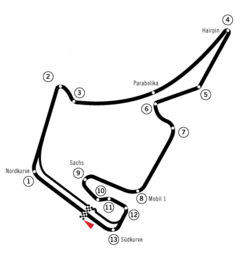Hockenheim

The Hockenheimring is situated near the town of Hockenheim in Baden-Württemberg, not far from Heidelberg, and located on Bertha Benz Memorial Route.
The circuit was originally built in 1932 using roads in the forest as an alternative to the Wildpark-Circuit in Karlsruhe, which became forbidden as a racing circuit by German officials. It was used for motorcycle racing and was expanded to be used as test track for Mercedes-Benz and Auto Union in 1936. In 1938 it was renamed the Kurpfalzring and that name was used until 1947.
The original circuit was almost 8km long and consisted of two long straights with a long "Eastern" corner in the forest and a U-turn inside Hockenheim joining them together.
In 1965, when the new A6 autobahn arrived & separated the village from the main part of the track, a new version of circuit was built, with the "Motodrom" stadium section. After Jim Clark was killed in 1968 in a Formula 2 racing accident, two chicanes and an Armco barrier were added. A small memorial was placed near the first chicane, at the site of his accident. In 1980, another chicane was added at the Ostkurve (east curve), after Patrick Depailler was killed there.
After protest from the FIA to greatly improve spectator viewing, safety and security at the track, the state government of Baden-Württemberg secured the financing of the redesign by Hermann Tilke for the 2002 German Grand Prix. The stadium section remained mostly intact, despite a new surface and a tighter Turn 1 ("Nordkurve"). However, the circuit was dramatically shortened, with the long, sweeping forest section chopped off in favour of more tight corners. The old forest section was torn up and replanted with trees.
The complex also features a quarter mile track for drag racing and hosts one of the largest drag racing events in Europe known as the NitrOlympx.

